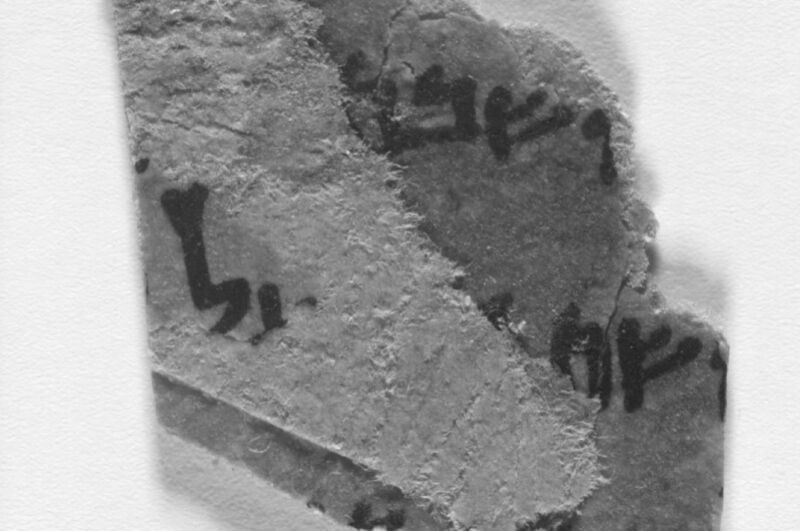
The 16 purported fragments of the Dead Sea Scrolls in the Museum of the Bible might be fakes, but at least four such fragments housed at the University of Manchester in the UK are the real deal. For decades, those fragments were presumed to be blank, but a new analysis has revealed the existence of actual text, most likely a passage from the book of Ezekiel.
These ancient Hebrew texts—roughly 900 full and partial scrolls in all, stored in clay jars—were first discovered scattered in various caves near what was once the settlement of Qumran, just north of the Dead Sea, by Bedouin shepherds in 1946-1947. Qumran was destroyed by the Romans, circa 73 CE, and historians believe the scrolls were hidden in the caves by a sect called the Essenes to protect them from being destroyed. The natural limestone and conditions within the caves helped preserve the scrolls for millennia; they date back to between the third century BC and the first century CE.
The scrolls are understandably of great historical and archaeological interest. Several of the parchments have been carbon dated, and synchrotron radiation, among other techniques, has been used to shed light on the properties of the ink used for the text.
A comprehensive set of imaging techniques were used to determine that the Museum of the Bible fragments were forgeries. In 2018, an Israeli scientist named Oren Ableman used an infrared microscope attached to a computer to identify and decipher Dead Sea Scroll fragments stored in a cigar box since the 1950s. (One of the fragments could not be attributed to any of the known manuscripts, and thus may represent a still unknown manuscript.)
Last year we reported on a study of the nearly 25-foot-long Temple Scroll, among the best preserved of the Dead Sea Scrolls. The text appears to cover some version of material found in the Biblical books of Exodus and Deuteronomy, including plans for a Jewish temple, and rules regarding temple practices and sacrificial offerings. That study concluded that the parchment has an unusual coating of sulfate salts (including sulfur, sodium, gypsum, and calcium), which may be one reason the scrolls were so well-preserved.
This is not first time hidden text has been revealed on fragile ancient artifacts thanks to cutting-edge technology. In 2016, an international team of scientists developed a method for "virtually unrolling" a badly damaged ancient scroll found on the western shore of the Dead Sea, revealing the first few verses from the book of Leviticus. The so-called En Gedi scroll was recovered from the ark of an ancient synagogue destroyed by fire around 600 CE.
And in 2019, we reported that German scientists used a combination of cutting-edge physics techniques to virtually "unfold" an ancient Egyptian papyrus, part of an extensive collection housed in the Berlin Egyptian Museum. Their analysis revealed that a seemingly blank patch on the papyrus actually contained characters written in what had become "invisible ink" after centuries of exposure to light.
-
Naked eye view of a scroll fragment (left). Multispectral imaging of the same scroll fragment (right).University of Manchester
-
Joan Taylor examining the Dead Sea Scrolls fragments in the John Rylands Library Reading Room.University of Manchester
The Manchester fragments never entered the antiquities market, where many forgeries originated. After being unearthed during the excavations of the Qumran caves, the fragments were given to the Kingdom of Jordan in the 1950s by a leather expert at the University of Leeds named Ronald Reed. He did so in exchange for permission to study them, since they were presumed to be blank. They remained in long-term storage until 1997, when the collection was donated to the university. It was while examining them as part of the new study that Joan Taylor of King's College London noticed a striking detail.
“Looking at one of the fragments with a magnifying glass, I thought I saw a small, faded letter—a lamed, the Hebrew letter ‘L,’” said Taylor. “Frankly, since all these fragments were supposed to be blank and had even been cut into for leather studies, I also thought I might be imagining things. But then it seemed maybe other fragments could have very faded letters, too.”
Intrigued, Taylor photographed the front and back of all the blank fragments over one centimeter—51 in all—using multispectral imaging (MSI), a technique that is being used more frequently in archaeology because it can reveal hidden materials, pigments, and inks that would be invisible to the naked eye. As Sarah Bond noted at Forbes in 2017, "MSI can take three visible images in blue, green and red and combine them with an infrared image and an X-ray image of an object in order to reveal minute hints of pigment. It can even reveal hidden drawings, stains or writings underneath various layers of paint or grime."
Four of the 51 fragments so analyzed had readable text written in carbon-based ink, along with parts of characters and ruled lines. “With new techniques for revealing ancient texts now available, I felt we had to know if these letters could be exposed," said Taylor. "There are only a few on each fragment, but they are like missing pieces of a jigsaw puzzle you find under a sofa.”
Taylor found that one fragment in particular showed the remnants of four lines of text, consisting of about 15 letters. Only one word, Shabbat (Sabbath), was readable, but based on her analysis, she thinks the text relates to the passages in Ezekiel 46:1-3. The team's analysis of the fragments is ongoing, and a report on their results will be published later. In the meantime, the University of Manchester has the distinction of housing the only authenticated Dead Sea Scrolls in the UK.
"four" - Google News
May 27, 2020 at 06:59PM
https://ift.tt/3c2eRTv
Scientists discover that four “blank” Dead Sea Scrolls actually have text - Ars Technica
"four" - Google News
https://ift.tt/2ZSDCx7
https://ift.tt/3fdGID3

No comments:
Post a Comment